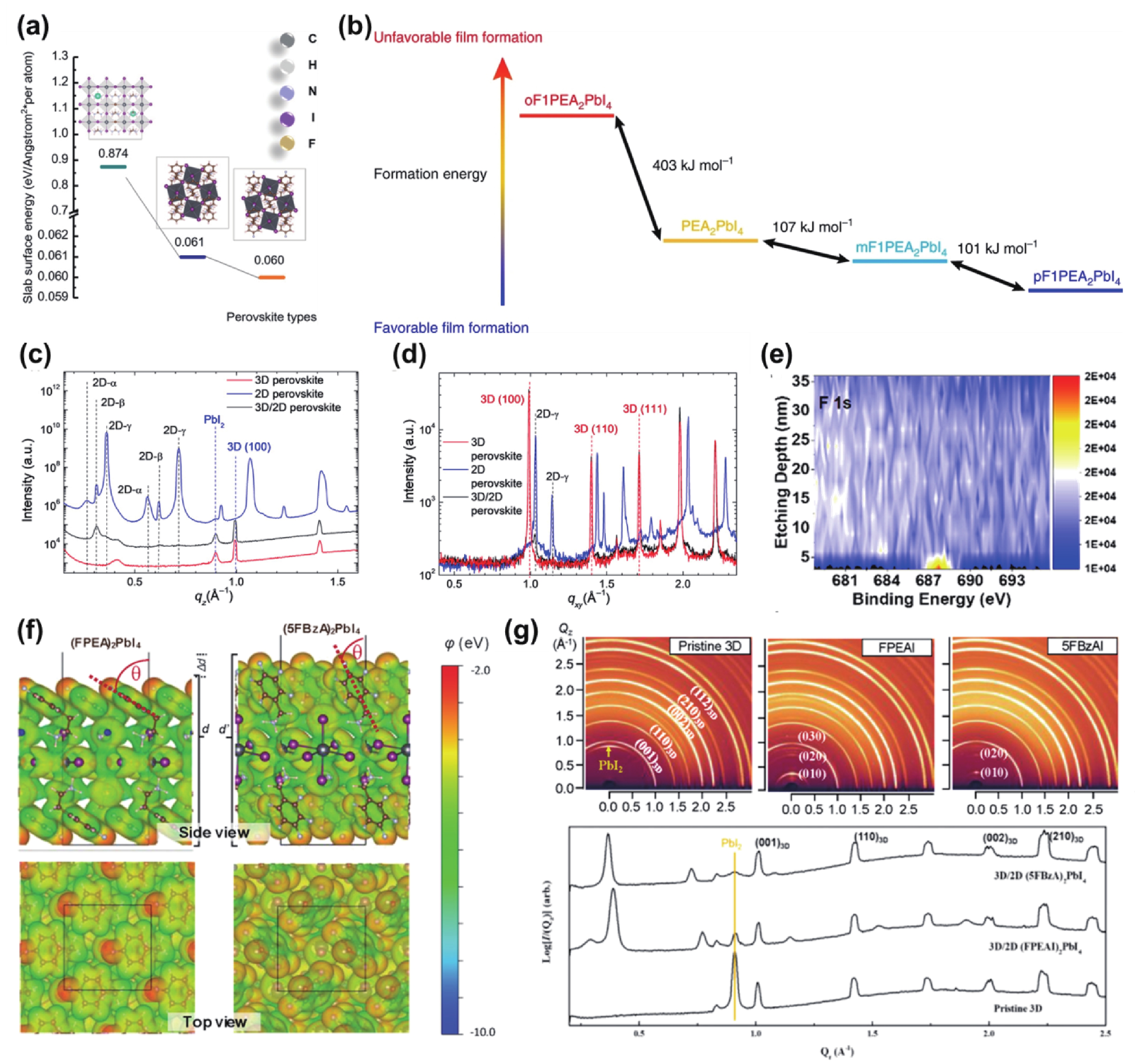| Citation: |
Qin Zhou, Chuantian Zuo, Zilong Zhang, Peng Gao, Liming Ding. F-containing cations improve the performance of perovskite solar cells[J]. Journal of Semiconductors, 2022, 43(1): 010202. doi: 10.1088/1674-4926/43/1/010202
****
Q Zhou, C T Zuo, Z L Zhang, P Gao, L M Ding, F-containing cations improve the performance of perovskite solar cells[J]. J. Semicond., 2022, 43(1): 010202. doi: 10.1088/1674-4926/43/1/010202.
|
F-containing cations improve the performance of perovskite solar cells
DOI: 10.1088/1674-4926/43/1/010202
More Information
-
References
[1] Mohd Yusoff A, Gao P, Nazeeruddin M. Recent progress in organohalide lead perovskites for photovoltaic and optoelectronic applications. Coord Chem Rev, 2018, 373, 258 doi: 10.1016/j.ccr.2017.10.021[2] NERL, National renewable energy laboratory. Best research-cell efficiencies. 2020[3] Wang Z, Shi Z, Li T, et al. Stability of perovskite solar cells:a prospective on the substitution of the A cation and X anion. Angew Chem Int Ed, 2017, 56, 1190 doi: 10.1002/anie.201603694[4] Cheng Y, Ding L. Pushing commercialization of perovskite solar cells by improving their intrinsic stability. Energy Environ Sci, 2021, 14, 3233 doi: 10.1039/D1EE00493J[5] Cheng Y, Yang Q D, Ding L. Encapsulation for perovskite solar cells. Sci Bull, 2021, 66, 100 doi: 10.1016/j.scib.2020.08.029[6] Akin S, Arora N, Zakeeruddin S M, et al. New strategies for defect passivation in high-efficiency perovskite solar cells. Adv Energy Mater, 2020, 10, 1903090 doi: 10.1002/aenm.201903090[7] Yang X, Fu Y, Su R, et al. Superior carrier lifetimes exceeding 6 µs in polycrystalline halide perovskites. Adv Mater, 2020, 32, 2002585 doi: 10.1002/adma.202002585[8] Liu G, Zheng H, Zhang L, et al. Tailoring multifunctional passivation molecules with halogen functional groups for efficient and stable perovskite photovoltaics. Chem Eng J, 2021, 407, 127204 doi: 10.1016/j.cej.2020.127204[9] Zuo C, Ding L. An 80.11% FF record achieved for perovskite solar cells by using the NH4Cl additive. Nanoscale, 2014, 6, 9935 doi: 10.1039/c4nr02425g[10] Liu X, Yu Z, Wang T, et al. Full defects passivation enables 21% efficiency perovskite solar cells operating in air. Adv Energy Mater, 2020, 10, 2001958 doi: 10.1002/aenm.202001958[11] Yu B, Zuo C, Shi J, et al. Defect engineering on all-inorganic perovskite solar cells for high efficiency. J Semicond, 2021, 42, 050203 doi: 10.1088/1674-4926/42/5/050203[12] Yang J, Liu C, Cai C, et al. High-performance perovskite solar cells with excellent humidity and thermo-stability via fluorinated perylenediimide. Adv Energy Mater, 2019, 9, 1900198 doi: 10.1002/aenm.201900198[13] Jiang X, Chen S, Li Y, et al. Direct surface passivation of perovskite film by 4-fluorophenethylammonium iodide toward stable and efficient perovskite solar cells. ACS Appl Mater Interfaces, 2021, 13, 2558 doi: 10.1021/acsami.0c17773[14] Gao P, Mohd Yusoff A, Nazeeruddin M. Dimensionality engineering of hybrid halide perovskite light absorbers. Nat Commun, 2018, 9, 5028 doi: 10.1038/s41467-018-07382-9[15] Hu Y, Schlipf J, Wussler M, et al. Hybrid perovskite/perovskite heterojunction solar cells. ACS Nano, 2016, 10, 5999 doi: 10.1021/acsnano.6b01535[16] Lin Y, Bai Y, Fang Y, et al. Enhanced thermal stability in perovskite solar cells by assembling 2D/3D stacking structures. J Phys Chem Lett, 2018, 9, 654 doi: 10.1021/acs.jpclett.7b02679[17] Wang Z, Lin Q, Chmiel F P, et al. Efficient ambient-air-stable solar cells with 2D-3D heterostructured butylammonium-caesium-formamidinium lead halide perovskites. Nat Energy, 2017, 2, 17135 doi: 10.1038/nenergy.2017.135[18] Cho K T, Grancini G, Lee Y, et al. Selective growth of layered perovskites for stable and efficient photovoltaics. Energy Environ Sci, 2018, 11, 952 doi: 10.1039/C7EE03513F[19] Chen P, Bai Y, Wang S, et al. In situ growth of 2D perovskite capping layer for stable and efficient perovskite solar cells. Adv Funct Mater, 2018, 28, 1706923 doi: 10.1002/adfm.201706923[20] Dalvi V H, Rossky P J. Molecular origins of fluorocarbon hydrophobicity. Proc Natl Acad Sci, 2010, 107, 13603 doi: 10.1073/pnas.0915169107[21] Bi D, Gao P, Scopelliti R, et al. High-performance perovskite solar cells with enhanced environmental stability based on amphiphile-modified CH3NH3PbI3. Adv Mater, 2016, 28, 2910 doi: 10.1002/adma.201505255[22] Slavney A H, Smaha R W, Smith I C, et al. Chemical approaches to addressing the instability and toxicity of lead-halide perovskite absorbers. Inorg Chem, 2017, 5646 doi: 10.1021/acs.inorgchem.6b01336[23] Zhou Q, Liang L, Hu J, et al. High-performance perovskite solar cells with enhanced environmental stability based on a (p-FC6H4C2H4NH3)2[PbI4] capping layer. Adv Energy Mater, 2019, 9, 1802595 doi: 10.1002/aenm.201802595[24] Zhang F, Kim D H, Lu H, et al. Enhanced charge transport in 2D perovskites via fluorination of organic cation. J Am Chem Soc, 2019, 141, 5972 doi: 10.1021/jacs.9b00972[25] Hu J, Oswald I W H, Stuard S J, et al. Synthetic control over orientational degeneracy of spacer cations enhances solar cell efficiency in two-dimensional perovskites. Nat Commun, 2019, 10, 1276 doi: 10.1038/s41467-019-08980-x[26] Zhou Q, Xiong Q, Zhang Z, et al. Fluoroaromatic cation-assisted planar junction perovskite solar cells with improved VOC and stability: the role of fluorination position. Sol RRL, 2020, 4, 2000107 doi: 10.1002/solr.202000107[27] Zhou Q, Gao Y, Cai C, et al. Dually-passivated perovskite solar cells with reduced voltage loss and increased super oxide resistance. Angew Chem Int Ed, 2021, 60, 8303 doi: 10.1002/anie.202017148[28] Liu Y, Akin S, Pan L, et al. Ultrahydrophobic 3D/2D fluoroarene bilayer-based water-resistant perovskite solar cells with efficiencies exceeding 22%. Sci Adv, 2019, 5, eaaw2543 doi: 10.1126/sciadv.aaw2543[29] Paek S, Roldán-Carmona C, Cho K T, et al. Molecular design and operational stability: toward stable 3D/2D perovskite interlayers. Adv Sci, 2020, 7, 2001014 doi: 10.1002/advs.202001014[30] Qiu Y, Liang J, Zhang Z, et al. Tuning the interfacial dipole moment of spacer cations for charge extraction in efficient and ultrastable perovskite solar cells. J Phys Chem C, 2021, 125, 1256 doi: 10.1021/acs.jpcc.0c09606[31] Wang L, Zhou Q, Zhang Z, et al. A guide to use fluorinated aromatic bulky cations for stable and high-performance 2D/3D perovskite solar cells: the more fluorination the better. J Energy Chem, 2022, 64, 179 doi: 10.1016/j.jechem.2021.04.063[32] Zhu H, Ren Y, Pan L, et al. Synergistic effect of fluorinated passivator and hole transport dopant enables stable perovskite solar cells with an efficiency near 24%. J Am Chem Soc, 2021, 143, 3231 doi: 10.1021/jacs.0c12802[33] Wang X, Rakstys K, Jack K, Jet al. Engineering fluorinated-cation containing inverted perovskite solar cells with an efficiency of > 21% and improved stability towards humidity. Nat Commun, 2021, 12, 52 doi: 10.1038/s41467-020-20272-3[34] Shi P P, Lu S Q, Song X J, et al. Two-dimensional organic-inorganic perovskite ferroelectric semiconductors with fluorinated aromatic spacers. J Am Chem Soc, 2019, 141, 18334 doi: 10.1021/jacs.9b10048[35] Jiang Y, Cui M, Li S, et al. Reducing the impact of Auger recombination in quasi-2D perovskite light-emitting diodes. Nat Commun, 2021, 12, 336 doi: 10.1038/s41467-020-20555-9 -
Proportional views






 DownLoad:
DownLoad:















